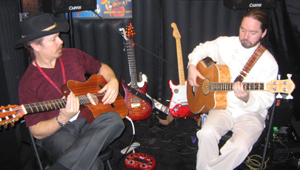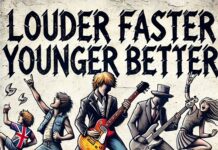By Shawn Perry
Subdued. It’s the first thing I notice when I walk through the entrance of the Anaheim Convention Center and into the 2005 NAMM (National Association of Music Merchants) show. Yeah, it doesn’t seem as congested and wild as the year before, and I couldn’t be more pleased about that. Parking was a breeze. Then again, it’s early Friday and anything is bound to happen between now and Sunday. So while I take comfort in the calm, I brace myself for the storm.
I continue down into the convention center’s belly (that’s the basement for you commoners) for a quick peak at some of the more interesting peripheral items — gizmos to exercise your guitar picking fingers, guitar picks that light up when you hit a string, slim-line doohickeys to amplify your flute or harmonica, and wood for building guitars, which, when you think about it, is pretty friggin’ important.

I watch a few intimate jam sessions, glimpse a guitar with an inverted body, and check out the metal lathes at Grizzly Industrial, Inc., along with a few other unmentionables that shall remain so for a stretch or two. I wander over to the escalator and head up to the main floor. And then I realize it was all an illusion; that the show is as crowded as ever and the NAMM buzz is in full flight. A barrage of drums, guitars, keyboards, horns, and other melodic sounds reverberate off the convention center’s walls and hit me like a sonic wave. I’m here again for the twentieth or so time and everything is right with the world.
I stroll over to the Peavey booth and take it all in: the guitars, basses, amplifiers, mixing boards, processors, microphones, speakers, and more accessories than any normal musician could ever need. Even without a show-stopping appearance by former longtime endorsee Eddie Van Halen, Peavey is holding its own with a cavalcade of vintage-style products. Who but Peavey would team up with a famous whiskey distillery to develop a batch of Jack Daniel’s guitars and amps? As I marvel at such a concept — how about a Gibson/Bacardi partnership? Perhaps Roland and Skyy? — I happen upon a showcase taking place in one of Peavey’s enclosed sound stages. On the stage is none other than world champion surfer Daize Shayne.
Aside from long boarding on the North Shore of Oahu, Daize is an aspiring singer/songwriter who hopes to parlay her booming surfing and modeling career into a successful musical sojourn. Her appearance at the 38th Republican National Convention last summer probably didn’t hurt her much, unless, of course, she’s planning to collaborate with Bruce Springsteen or the Dixie Chicks anytime soon. More than likely, however, is that her wholesome surfer girl looks, gritty vocals, and basic, old-school rock and roll vibe will attract her the attention she seeks. To be sure, she tells me it’s her first NAMM show and she’s raring to see it all.
From there, I go back over to the percussion minefield and notice a familiar face: Jethro Tull’s longtime drummer Doane Perry. Having interviewed bandmates Ian Anderson and Martin Barre, I’m keen to find out what brought Perry to the show. “My car brought me here,” he laughs. “And Paiste and Premier. I like to see what’s new. I love going into software land because I have a recording studio at home and so I love to keep up with all the digital stuff that’s happening. So after this, I’m going into the complete antithesis of drum world.”
Perry tells me Tull are heavily booked through the end of the year, but they’re hoping to get into the studio and record a new album. Barre told me the same thing two years ago, so I won’t hold me breath. Nevertheless, I can dream, can’t I?
After a roll through Roland to check out guitar effects, V-drums, and my obligatory licks from Beethoven’s Ninth on a new RD-700SX polyphonic digital piano, I decide to see what’s happening at Ernie Ball. When I arrive, I immediately notice the theme has been altered extensively from last year. Instead of a pirate ship, the scene resembles a sort of biker bar, complete with staff members bedecked in biker regalia and a CHP cop guarding the entrance to an actual bar. Apparently, you have to place a hefty order of guitar gear to gain entrance.
I’m tempted to buy anything from Ernie Ball until I see one of my favorite bass players meandering around the booth: Tony Levin. “I’m here as usual to look around and see a lot of friends,” he says. “And also to hang out with some of the instruments and amplifiers I play.”
I ask Levin about his return to King Crimson, and he assures me they’ve been rehearsing and writing for over a year. “But,” he adds, “Robert (Fripp) doesn’t feel we’re ready to record or tour yet, so we’ll see.”
Ah yes, the world of Crimson according to Fripp. I know it well. And damn it if the man’s intuition is normally right on the money. So I refrain from any further interrogations. After I finish talking to Levin, I realize I failed to ask him anything about Peter Gabriel or John Lennon, just two of the numerous legendary performers he’s anchored the lower end for. But no matter, I’m off to other adventures.

After looking over the tasteful Dimebag Darrell exhibit over at Dean Guitars, I traipse through software alley where Sony, Cakewalk and Apple demonstrate their latest music software products. Then I walk over to the Harman International room where JBL, Crown International, Digitech, Soundcraft, and various other subsidiaries are showing off their high performance audio products. You know, it just wouldn’t be right if I didn’t at least check out a line array or two just for the hell of it.
For some reason sound equipment makes me hungry, so I buzz on out and straight to the Hilton to quench my thirst. Sure, I’ll eventually eat, but not after a beer or two.
After chomping down a $5 bite-size pizza followed by a round of pool, it’s time to rock. I get an invite to ESP’s party where former Dokken guitarist George Lynch is manhandling his axe. Buffed out with a cigarette dangling from his lower lip, Lynch grinds out a rigid set highlighted by a cover of Deep Purple’s “Stormbringer” before handing the audience off to the new and improved Megadeth. And while I’ve never really followed them too much, I’m happy to see Dave Mustaine back in the driver’s seat, punching the pedal to the metal. It’s an invigorating display of visceral ping pong, and I’m as enthralled by the crowd as I am by the music. Peace sells, who’s buying a few more Coronas.
Day Two
Despite the fact that my brain is semi-comatose from the night before, I’m up early for a full day of interviews, booth hopping, and general loitering. I make some routine stops along the way. After stealing another peek at more exotic instruments in the basement, I make a beeline over to the escalator and up to the main floor I go again. After walking in circles for a few minutes, I suddenly find myself at the Monster Cable booth.

There, I recognize another familiar face — the voice, in fact, of Santana’s “Black Magic Woman,” “Evil Ways” and “Oye Como Va,” as well as a founding member of Journey — none other than keyboardist and vocalist Gregg Rolie. And what’s he doing at NAMM? “My son brought me here,” he laughs. When I press him about his latest activities, he tells me about the Gregg Rolie band, which includes Rolie’s old Santana band mate, conga player Mike Carabello and renowned jazz bassist Alphonso Johnson. They have a new album available through Rolie’s own web site at www.greggrolie.com. I later find out from guitarist Neal Schon that Rolie didn’t attend the Hollywood Star ceremony for Journey that took place earlier in the week. It seems a real shame that an original and pivotal member (and in this reporter’s opinion, the best singer Journey ever had) would pass up such an event. But who really knows what goes on behind the scenes.
Later, I’m back in the basement and I spot another keyboard player, the incomparable Rick Wakeman. After I tell him he’s one of my favorite musicians, Wakeman advises me to check out the GMedia Music’s Minimonsta, a fully programmable, polyphonic virtual vintage analog synthesizer based on the Moog Mini. “Minimonsta — that’s not the name of my ex-wife,” Wakeman reminds me as he is whisked away by a couple of executive types.

I mill around the basement for a while longer and talk with my friends at the Lite Pop booth where guitarist Rick Johnson and bassist Terry Law sizzle through a Latin-flavored jam and passersby check out the Disc Pops, Flash Picks, Tasty Licks and assorted other trinkets on display. Realizing that the show is about to close, I amble on over to the Hilton for a spell and then head home.
But my day is hardly over. Around 8:00, I get a call to come back to Hilton because the place is going off. I didn’t really need a phone call to find that out. Saturday night at the Hilton during the NAMM show is always a barnburner. My problem is that I’m still recovering from the previous night. But duty calls, so I climb back into my sled and head back to Anaheim.
The beauty behind my escapades on Friday night is that I am perfectly able to avoid doing anything foolish on Saturday night. As it so happens, I end up hanging out with a few heavy hitters who fill me in. After tipping back my one and only Corona of the night, I bump into the very affable bassist extraordinaire Billy Sheehan and ask him what he’s up to.

“Last night, I came down and did a show for the Sabian party. I played some of my new solo record Cosmic Troubadour,” he tells me between waves to various compatriots lingering about the Hilton bar. “And tonight I’m just hanging out with all my friends from the Hard Rock café.”
Then I spot Journey guitarist Neal Schon on the other side of the bar. He’s wearing sunglasses, looking as cool as toast. So, I amble over and see what he has to say. And he proceeds to run through a whole list of activities for me.
“I have my guitar unleashed by Gibson this year and we’re totally excited about it. They let me redesign the guitar. They had to buy a machine to make it. The knobs are reconfigured. You got one master volume, a sustainer, new inlays, a new headboard. It’s a great thing,” he enthuses, taking a breath. “I can design stuff because I’ve been playing for a long time and I know what I want.”
Musically speaking, Schon is as busy as ever. “We did the walk of fame the other night and then we played the House of Blues. Steve Smith came down and jammed with us and ripped it up. Aynsley Dunbar came down. Steve Perry didn’t make it, but he came to the ceremony. The only guy who didn’t make it was Gregg Rolie.”
By this time, it’s getting late and I decide to call it a day. I make a brief appearance the following day to double-check a couple of things, but for the most part, I’m finished with this year’s NAMM show. While it wasn’t as crazy as last year, the 2005 NAMM show was a smashing success and I’m sure I’ll be here again, talking shop, swapping stories, and digging the toys that make music.






















